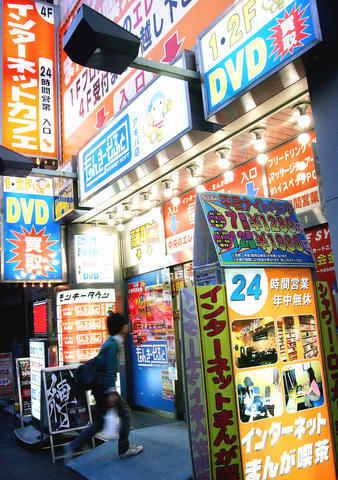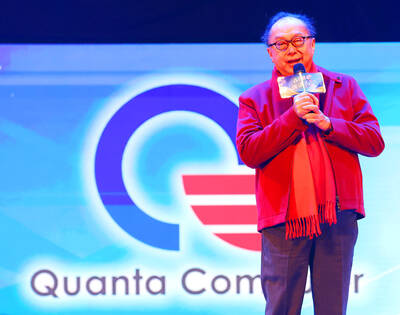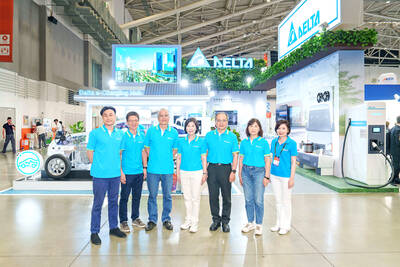It's almost midnight as Ryo settles into a reclining chair for the night, a can of tea and a pack of cigarettes at his side, a construction job awaiting him in the morning.
For the time being, this cramped cubicle at an Internet cafe -- with its TV and flickering PC monitor -- is home.
Ryo, who refused to give his full name, is part of what experts believe is a new social stratum in Japan: poor, young people who live out of 24-hour Internet cafes.

PHOTO: AP
Though there are no reliable numbers, experts warn a growing number of younger Japanese are sleeping in Net cafes like Ichigo, where the 30-year-old Ryo spends five nights a week. He stays with a friend on weekends.
The rising number of "Internet cafe refugees," as they are known, has raised enough concern that the Health Ministry is preparing to study the 1,300 Internet cafes nationwide.
Last year, 13 people contracted tuberculosis at an Internet cafe just west of Tokyo that health officials suspect originated from the cafe's homeless population, Tomohiro Uchino of the Health Ministry's social welfare department said.
phenomenon
"The phenomenon raises many issues in terms of health, labor and welfare," Uchino said. "The problem is that we don't yet have an accurate picture of how many homeless people there are in Internet cafes, how they got there, or how the government can intervene."
Behind the rise of Net refugees is Japan's ballooning population of young people who hop from one temporary job to the next.
They are believed to number more than 2 million -- a byproduct of the economic crisis that hit Japan a decade ago, as well as a shift in values in a younger generation less ready to conform to the corporate work ethic of their parents and grandparents.
Ryo said part of the reason he ended up homeless was an expensive interest in reggae music. In his twenties, he staged reggae events with his friends and even took trips to Los Angeles to study with musicians there. But then his savings ran dry.
In a city where a studio apartment rarely costs less than ¥100,000 (US$825) a month, the cafes appeal to people like Ryo.
cubicle
At Ichigo, clients pay ¥100 an hour for a small cubicle equipped with a reclining chair, computer and TV. Many cafes offer free refills of soft drinks; some even have showers. But the air is stale with cigarette smoke and there is a constant whine of computers, TVs and ventilation fans.
The urban refugees are modern-day versions of the day laborers of Osaka and other big Japanese cities who fueled the tumultuous economic growth of the 1960s -- an underclass that lodged in cheap hostels and who were rounded up each morning to work at nearby construction sites.
Some inhabitants of Net cafes also find work by the day, albeit in a more technology-savvy way. Many rely on their cellphones to arrange casual jobs, said Makoto Yuasa, who heads a homeless support center in Tokyo.
The arrangement means workers are not required to provide a set address, Yuasa said. However, the casual nature of the work means such workers often receive minimal wages and no training, social security or health insurance.
"With some job agencies, you get a call or an e-mail the night before, telling you where to turn up to work the next day," Yuasa said. "Many are menial cleaning or factory jobs that don't lead anywhere."
A government survey released earlier this year found about 18,500 homeless people across Japan, mostly aged 40 or older. That was down 27 percent from a similar survey four years ago. But the Net cafe refugees signal the existence of hidden forms of homelessness in Japan, especially among younger people, Yuasa said.
The young homeless also congregate in all-night saunas and the more traditional flophouses, where the older homeless people able to afford lodging are more likely to be found.
Young people have even been spotted catching up on sleep at the nation's 900 McDonald's restaurants open round-the-clock, according to local media reports. The media has dubbed them "McRefugees."
"We don't think this is a big problem at this point," a spokesman at McDonald's Holdings Company Japan said.
"Our staff patrol stores at night and close off unneeded sections, and people who look like they are using our stores only to sleep are sometimes asked to leave," he said.

Quanta Computer Inc (廣達) chairman Barry Lam (林百里) is expected to share his views about the artificial intelligence (AI) industry’s prospects during his speech at the company’s 37th anniversary ceremony, as AI servers have become a new growth engine for the equipment manufacturing service provider. Lam’s speech is much anticipated, as Quanta has risen as one of the world’s major AI server suppliers. The company reported a 30 percent year-on-year growth in consolidated revenue to NT$1.41 trillion (US$43.35 billion) last year, thanks to fast-growing demand for servers, especially those with AI capabilities. The company told investors in November last year that

Intel Corp has named Tasha Chuang (莊蓓瑜) to lead Intel Taiwan in a bid to reinforce relations between the company and its Taiwanese partners. The appointment of Chuang as general manager for Intel Taiwan takes effect on Thursday, the firm said in a statement yesterday. Chuang is to lead her team in Taiwan to pursue product development and sales growth in an effort to reinforce the company’s ties with its partners and clients, Intel said. Chuang was previously in charge of managing Intel’s ties with leading Taiwanese PC brand Asustek Computer Inc (華碩), which included helping Asustek strengthen its global businesses, the company

Taiwanese suppliers to Taiwan Semiconductor Manufacturing Co. (TSMC, 台積電) are expected to follow the contract chipmaker’s step to invest in the US, but their relocation may be seven to eight years away, Minister of Economic Affairs J.W. Kuo (郭智輝) said yesterday. When asked by opposition Chinese Nationalist Party (KMT) Legislator Niu Hsu-ting (牛煦庭) in the legislature about growing concerns that TSMC’s huge investments in the US will prompt its suppliers to follow suit, Kuo said based on the chipmaker’s current limited production volume, it is unlikely to lead its supply chain to go there for now. “Unless TSMC completes its planned six

Power supply and electronic components maker Delta Electronics Inc (台達電) yesterday said it plans to ship its new 1 megawatt charging systems for electric trucks and buses in the first half of next year at the earliest. The new charging piles, which deliver up to 1 megawatt of charging power, are designed for heavy-duty electric vehicles, and support a maximum current of 1,500 amperes and output of 1,250 volts, Delta said in a news release. “If everything goes smoothly, we could begin shipping those new charging systems as early as in the first half of next year,” a company official said. The new